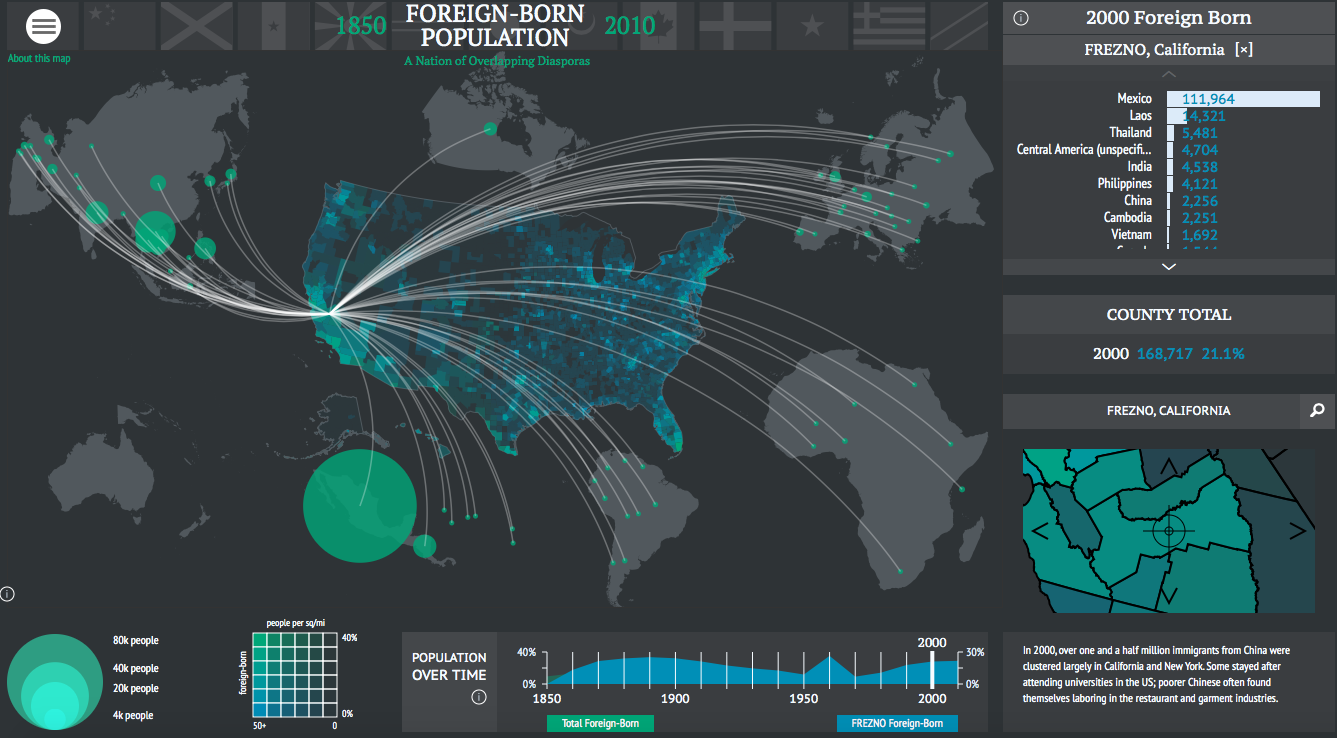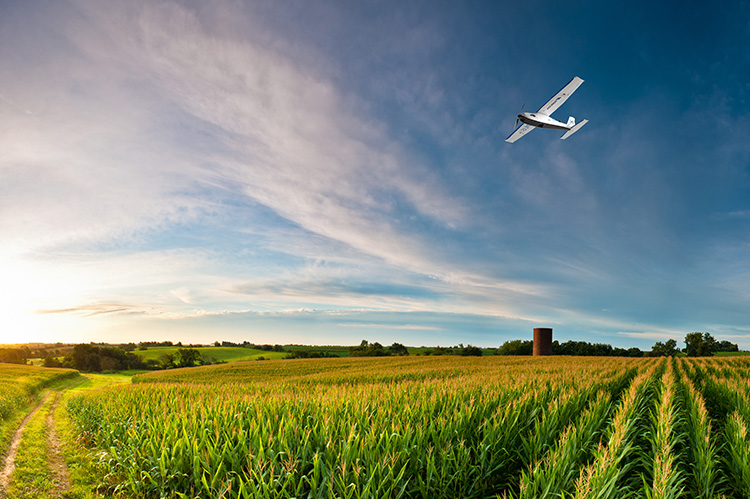
According to the FAO, the growth rates of global agricultural production and crop yields have slowed in the last couple of years, raising fears that the world may not be able to grow enough food and other commodities to ensure that future populations are adequately fed. Considering climate change as an important factor in world farm production, the growth rates of global production may further be endangered by failure of rains and occurrence of natural disasters such as floods and droughts leading to crop failures, food insecurity, famine and mass migration together with negative national economic growth. That’s why the risk management in agriculture is becoming an important tool for farmers to anticipate, avoid and react to shock.
Use of GIS in risk management as well as improving data visualisation and decision making process with the help of maps is becoming a standard for agencies, insurance companies and businesses around the world. Digital maps can display spatial correlations and patterns that are difficult to see in spreadsheet-based reports. Moreover, web based GIS solution can be an incredible tool for collaboration between stakeholders in risk management, namely insurance providers, farmers and governmental agencies.
We bring you a case study with an example of an agricultural risk management project where insurance company used airborne multispectral imagery to evaluate the impact hail damage on corn for the purpose of insurance claim assessment.
Goals and Challenges
The insurance company used drone generated NDVI map to have an overview of the hail damage in corn. This was a pilot project designed for improving their damage assessment process. They needed a solution for field inspection, data sharing and collaboration between the parties involved in an insurance claim case.
Their main goal was to create a solution combining Remote sensing technology with related ancillary data collection within GIS to gain an advanced and accurate tool for assisting with crop hail damage insurance settlements in minimal time and without conflict, while keeping expenses low. The challenge was in finding the best way for sharing large raster datasets with farmers without experience in GIS, together with improving the collaboration process so that settlements could be done in a more efficient way.
Workflow
A few days after the hail, the insurance company used drones to create an overview of the corn field crop damage. The area of 660 acres was mapped using MaVinci Sirius Pro unmanned vehicle. 758 images were generated by UAV, using RTK GPS positioning system and near-infrared sensor imagery. The results of drone image processing were orthomosaic, NDVI_rainbow, NDVI_heat and NDVI_gray images.
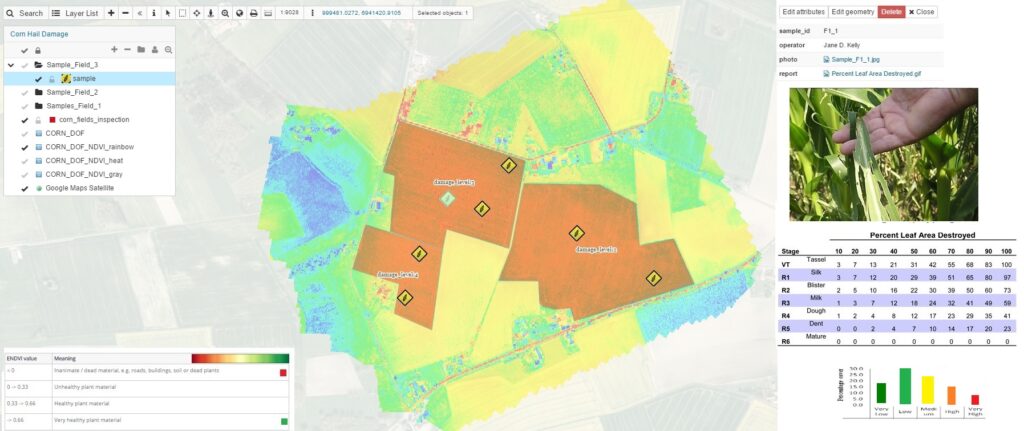
Insurance company used NDVI map to determine the intensity and area of crop fields damage
“NDVI or Normalized Difference Vegetation Index is a measurement of the amount of live vegetation in an area and is commonly used for agricultural assessment. The basic principle of NDVI relies on the fact that, due to their spongy layers found on their backsides, leaves reflect a lot of light in the near infrared, in stark contrast with most non-plant object. When the plant becomes dehydrated or stressed, the spongy layer collapses and the leaves reflect less NIR light, but the same amount in the visible range. Thus, mathematically combining these two signals can help differentiate plant from non-plant and healthy plant from sickly plant.”
Insurance company consultants and analysts can use NDVI data to determine the intensity and area of crop fields damage by analyzing NDVI pixel intervals using NDVI map (with a scale range from -1 to +1). Inanimate or dead material (roads, buildings, soil or dead plants) is displayed in red, while plants are displayed in green, making the hail damaged area easily visible on a map. This analysis helps generating parameters for insurance claim assessments.
NDVI map was of great help for the field inspection process. After processing data, analysts from insurance company were able to determine which areas require their immediate attention. Data visualisation helped them to make the workflow more efficient – they knew where to go and take the samples just from a quick look to a map.
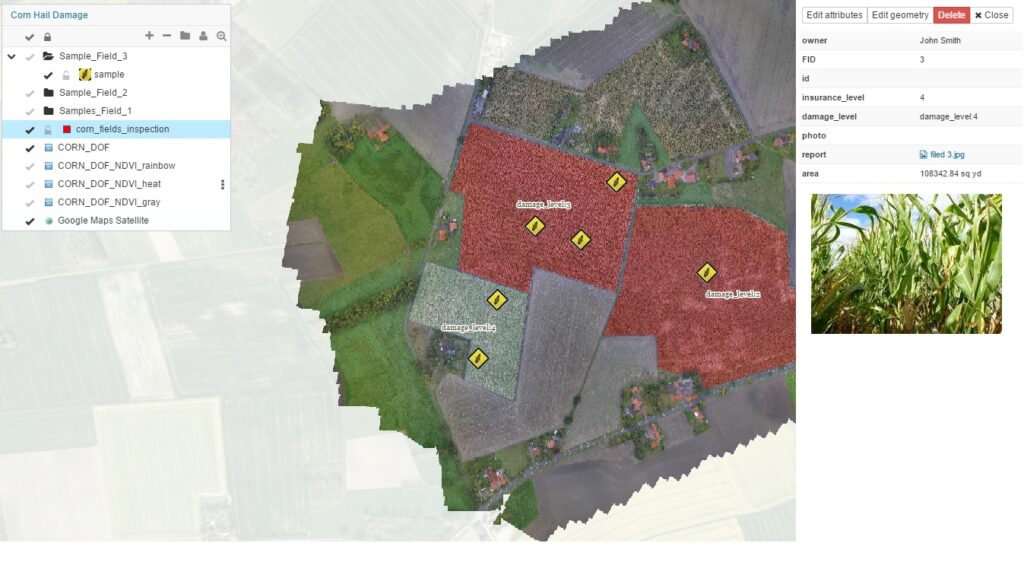
Sensor data was uploaded to different layers through Map Editor, making it available on the cloud and therefore easily accessible. Insurance company used polygon layers to mark the insured areas with additional information on insurance levels for each sector, together with damage indexes provided by processing the NDVI data. One layer included the sample data from the field investigation.
Analysts used NDVI map as a basemap for field investigation with the help of Mobile Data Collection application to pinpoint locations where field samples were taken (marked in yellow), together with attaching field photos directly to the marked location. Later, these locations were updated with the scouting results in the form of pdf, making all the data available on a web map. ‘Samples’ layer was populated with three types of sample data for each area: red NDVI area (<0.00; dead plants), yellow NDVI area (0 – 0.33; unhealthy plant material) and green NDVI area (0.33 – 0.66; healthy plants).
Mapping data was available for private sharing through Map Viewer application. It enabled easy data access for field crews who were collecting samples in the field.
Creating a Better Workflow after the Preliminary Assessment
After finishing the scouting process, consisted of observing the mapping data combined with the field sample inspection, insurance provider needed to verify survey data and create a damage assessment.
When the preliminary assessment phase was finished, insurance provider needed to share the data with interested sides, in this case farmer whose crops were damaged and the Agricultural Development Authority providing one-time support to the farmers in the case of hail.
They used Maplim to provide extra information to the sensor and sample data shown on a map providing a base for creating assessment parameters.
Maplim was an important part of a better workflow in terms of collaboration. It enabled all the stakeholders to communicate in real time on a map, without a need for face-to-face meetings. Methodology was discussed on a map serving as a workboard, where insurance company coordinated their arrangements and provided additional explanations concerning the assessment process.
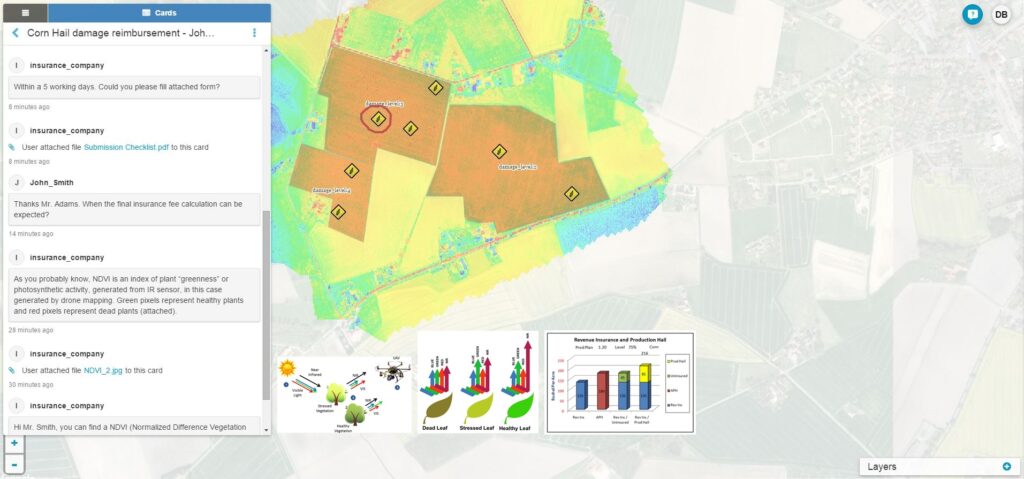
Maplim: the best way to collaborate on a map. An example of using cards to create a workflow streamline for all the stakeholders in a project.
What have we learned?
Insurance company offered us the following conclusions:
1. Multispectral imagery (airborne or satellite) is adequate for detection of the ground area and relative level of hail damage in corn for typical American agricultural areas.
2. Drones with integrated GPS RTK technology are able to provide spatial resolution up to 2 inches.
3. Damage assessment based on airborne remote sensing is faster and more accurate than currently used, field-oriented, hail-damage adjustment procedures.
4. Combination of NDVI map generated from drone images and GIS technology in the cloud is great tool for agricultural risk management insurance company. The key values are:
- uploading big raster data
- using GIS tools such as creating polygons, lines and points and adding attribute data are helpful in improving the data visualisation process etc.
- sharing and collaboration functionality
5. With the help of cloud-based GIS, all the stakeholders can be easily involved in the process: owner, insurance manager, local authority for agriculture and others, without a need for special expertise in using software
In abstract, using drones in agricultural risk management provides an easy and efficient way for generating up-to-date overview of the crop damage. In case of huge farming areas typical for North and South America, Australia and Eastern Europe, this technology can be used to improve crop monitoring in all phases.
Combination of drone mapping and cloud GIS technology is an excellent way to create ‘added value’ to the mapping data – both through GIS functionality (polygons, layers, attached data) and data sharing with collaboration, including different stakeholders in a real-time project. Cloud GIS can be a great decision-making tool, helping agricultural agencies and companies to improve their understanding of the data in a fast, accurate and efficient process.
GIS Cloud applications used: Map Editor, Mobile Data Collection, Map Viewer, Maplim
Read more at GIS Cloud blog

